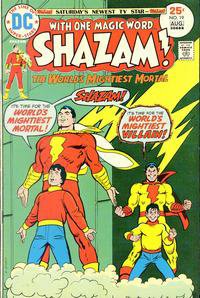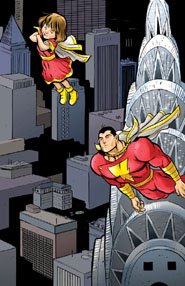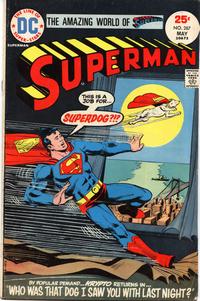Friday, January 20, 2006
Furious Fives

Kevin did it, so I dood it.
Five Perfect Pop Singles
1. "Glad Girls", Guided by Voices
2. "We Can Work It Out", Stevie Wonder
3. "Starry Eyes", The Records
4. "True Blue", Rod Stewart
5. "Maps", Yeah Yeah Yeahs
Five Perfect Back Issues
1. Kamandi #29 (gorilla Superman worshippers)
2. Suicide Squad #22 (Rick Flag commits murder)
3. Brave And The Bold #108 (Batman and Sgt. Rock vs. Hitler/Satan)
4. Superman #252 (Neal Adams wraparound cover, all reprint 100 pager)
5. Saga of the Swamp Thing #30 ("A Halo of Flies")
Five Perfect Toys
1. Raydeen Shogun Warrior
2. Acroyear Micronaut
3. Star Wars Millenium Falcon
4. Mego Green Arrow
5. Superfriends Colorforms
Five Perfect Kirby Creations:
1. M.O.D.O.K.
2. Ookla the Mok
3. Black Panther
4. Funky Flashman
5. The Mountain of Judgment
Five Perfect Alcoholic Drinks
1. Kir Royale
2. Classic Cosmopolitan
3. Bass Ale
4. Whiskey Sour
5. Mint Russki (frozen Grey Goose and mint leaves)
1975: Shazam!

Is there a more quixiotic place in superhero fandom than the Captain Marvel message board at dccomics.com? Earnest fans trade detailed essays on "Making Captain Marvel Popular Again", post angry tirades about DC's supposed conspiracy to marginalize the character, relish and debate brief guest appearances in other heroes' comics, even launch discussions of different artists' renditions of the character's vambrances (the yellow/golden bracers on Cap's forearms.) Cloth or metal, where do you stand? Really, this is no different than any other fan message board--except all of this activity is for a character who more or less faded out in 1955, sued out of existence (and later bought by) Superman's publishers. Despite the similarity to so many other chat boards about equally trival pop culture, the place is positively haunted by a pronounced sense of people desperately passing the time until they are overtaken by sweet, sweet death. Maybe I'm being a bit harsh.
Like many people my age, my first exposure to Captain Marvel came with the terrible CBS Saturday morning series (Winnebago, Mentor, a production budget envious of Dr. Who)--and with DC's first misguided attempt at reviving the character for the comics. Even as a little kid I thought the Shazam comic was at best okay, with appealing art by the likes of Kurt Schaffenburger, but with limp stories that seemed intended for an audience that even then no longer existed. I can't tell you word one about the comic shown here, my first issue. The costume color reversal is striking, and the cover sells the book. But it was clear from the interiors that DC just didn't know what to do with Captain Marvel. The stories typically came off as insincere or half-hearted approximations of the surface naivete of Otto Binder's light, comedic Golden Age Cap strips. Beck, associated with the revival in its early issues, quickly walked out over the poor quality of the scripts. 30 years later, DC still hasn't figured it out.
And I don't think they ever will. Because their marketing imperative, to keep the trademark viable for movie options, merchandise, comics, etc., will always run up against the fact that this is simply a dead character, unworkable outside his orignal context. Captain Marvel, like Jack Cole's Plastic Man, Jack Kirby's New Gods, Will Eisner's Spirit and a few other properties, is the superhero equivalent of John Travolta in The Boy In the Plastic Bubble. Outside his original protective environment he chokes and dies. Every time DC puts him on that horse to ride free and feel the wind on his cheeks, he's going to expire.
In part, this is because Captain Marvel's original, massive success is tied so closely to the distinctive cartoonish style of original Cap artist C.C. Beck and his studio. All other modern verisions either seem off-model or slavishly imitative, and in either case pointless. Plastic Man and Kirby's Fourth World suffer from the same problem; subsequent artists, toiling in the long shadows of the original creators, try to navigate the impossible path between redundant (John Byrne on anything originated by Jack Kirby after X-Men) and wrong (Grant Morrison's Jim Carreyesque Plastic Man). The original Captain Marvel also exhibited a guilelessness common to family entertainment of the 1940s and 50s which is unthinkable today. In some ways Beck and Binder's Captain Marvel talked down to its intended audience much as a strip like Owly does today--a condescending adult's conception of what a kid should like. Of course, Captain Marvel sold over a million copies every three weeks at its 40s peak, so maybe Beck and Binder were onto something.
In any event, time and talent are not all that stands in the way of a successful Captain Marvel relaunch. Unlike the other superheroes who survived the 1940s, and all those who came later Captain Marvel as an idea uniquely depends on an audience comprised--if not exclusively, at least mainly--of children. That's because the wish fulfillment of the character, worn on his vambrance, is one of a little kid magically granted an adult's assumed power to right wrongs and affect his environment. When you've got a bunch of kids reading that, no problem.
But kids don't read superhero comics anymore. Adult men do. And that means the central fantasy of Captain Marvel gets flipped on its head, in a manner decidedly unflattering to the reader. Instead of a boy who miraculously becomes an adult, Captain Marvel is inescapably an adult frame hiding the innocent, helpless boy inside. Which is how many aging comic book fans undoubtedly see themselves. The other option for adult readers is to envision Captain Marvel as a stonger, more competent version of their ineffecttual adult selves. Both readings trade in pathos.
After trying and failing to ape Beck and Binder for a few years, DC tried an approach that married goofy, Golden Age plotting with slightly deeper characterizations and detailed art by Don Newton. This version ran as a back-up strip in an anthology, and is (along with the Joe Staton-drawn Plastic Man of the same era) probably the most successful shot at Captain Marvel. Unfortunately, in today's marketplace anthologies and back-up strips, a natural home for a semi-retired character with limited potential, are also dead.
 Since then, DC has tried to graft various levels of "realism" onto the Big Red Cheese, all of them miserable failures. It always feels like a zombie shuffling around in a Captain Marvel suit, a sad display of Captain Marvel-like chin-jutting, arm-waving and noise-making cloaking a hidden desire to eat the reader's brain. The most recent low point, courtesy of Geoff Johns, involved a realistically-drawn Captain Marvel being lectured by the old men of the Justice Society for becoming romantically involved with a young teenage girl...because they don't realize he's just a teenager too, underneath his big hairy flesh suit! Exploring a case of mistaken pedophilia is something nobody needed to see from Captain Marvel, but is the logical outcome of forcing a square superhero into a pseudo-psychologically "real" hole. And if that sounds dirty to you, you shouldn't be reading Captain Marvel comics.
Since then, DC has tried to graft various levels of "realism" onto the Big Red Cheese, all of them miserable failures. It always feels like a zombie shuffling around in a Captain Marvel suit, a sad display of Captain Marvel-like chin-jutting, arm-waving and noise-making cloaking a hidden desire to eat the reader's brain. The most recent low point, courtesy of Geoff Johns, involved a realistically-drawn Captain Marvel being lectured by the old men of the Justice Society for becoming romantically involved with a young teenage girl...because they don't realize he's just a teenager too, underneath his big hairy flesh suit! Exploring a case of mistaken pedophilia is something nobody needed to see from Captain Marvel, but is the logical outcome of forcing a square superhero into a pseudo-psychologically "real" hole. And if that sounds dirty to you, you shouldn't be reading Captain Marvel comics.Jeff Smith, creator of the independent comic Bone, is currently at work on a Captain Marvel mini-series for later this year. If anyone can pull off a decent Captain Marvel story mixing whimsy with a modern sensibility, it's him. But just like Darwyn Cooke on The Spirit, it seems like a waste of talent.
Monday, January 16, 2006
1975: Krypto

Back in college I took a creative writing workshop in which we were all asked to name the fiction that had most influenced our own work. "The Yellow Wallpaper," said one student. "White Noise," said another. "Krypto the Superdog" said a third. In a voice that sounded just like mine.
As a four-year-old, I had already seen a lot of crazy shit in comic books in 1975: a freckled ghost in a bowler hat, a devil in a diaper, a girl who essentially became sexually excited by dot patterns. But none of that prepared me for the sheer creative gall of Krypto the Superdog, whom I first discovered in my very first issue of Superman, #287.
The story, "Who Was That Dog I Saw You With Last Night?" (recently--and rightly--reprinted in the Superman in the Seventies collection) returned Krypto to Superman's life after years of absence while DC did its relevance thing in the early 70s. Writer Elliott S! Maggin explained Krypto's disappearance with a convenient bout of dog amnesia. (I'm pretty sure my dog Hope suffers from similar brain damage.)
But let me back up a bit to explain Krypto. Of course, the minute you see a dog streaking gracefully across the sky in a bright red cape you've pretty much got the concept. For many years a staple of the Superman legend was that he spent his childhood in Smallville, Kansas as Superboy, foiling robbers at the local seed exchange as he geared up for an adulthood of smashing killer robots and throwing shit into the sun. After about 10 years of this, the Superboy writers hit on the one-shot idea of introducing a super dog to keep their super boy company. So, in a 1955 story, Superboy first met Krypto. Seems that Superboy's birth father, the kindly Kryptonian scientist Jor-El, ripped his toddler son's puppy out of his arms to conduct a rocket test. Well, wouldn't you know it, years later that rocket coincidentally made its way not only to Earth but straight to Superboy's town. It's a small universe. At any rate, young Clark is all excited to have his own superpet, but soon realizes that a dog who plays by ripping the wings off airplanes is a giant pain in the ass. At the end of that first story Krypto heads out into space to chase comets, and Superboy sheds a self-pitying tear for himself. I guess the letters from readers rolled in hot and heavy, becuase Krypto found his way back pretty quick, this time with his own thought balloons, a full-time cape and a much mellower personality. He remained as a staple of Superboy (and occassionally Superman and Legion of Suepr-Heroes) comics for the next 15 years. Then around 1970, DC decided to sidestep some of the sillier aspects of its Superman lore and Krypto was quietly shown the doggie door. But you can't keep the greatest, most absurd single idea in comics down for long, and thanks to Maggin Krypto was back yet again within just a few years. Precisely in time for me to start reading Superman. Thanks, paws of fate!
While the other students in my college writing workshop laughed at my "joke", I really kind of meant it. In the years since first discovering Krypto, I've witnessed a lot of things. I've seen Shakespeare use language to perform graceful dances of ideas that leave me breathless. I've fallen in love. I've seen women naked. I've gotten married. I've seen my words on billboards as I roll down the interstate. I've seen my first son carried through the gate at the airport, looking up to meet me for the first time. I've watched my wife give birth. None of these things has a doghouse on a fucking asteroid, okay?
While many modern Superman fans cringe at the idea, I insist that Krypto is everything good about superhero comics. There's such joy and imagination in the concept--an absurd idea built on a history of other absurd ideas, one clearly designed to appeal to kids. Most of the classic Superboy and Krypto stories from the 50s and 60s revolve around loyalty and abandonment issues--the perfect themes for stories about a boy and his dog. "Why is my master Superboy poisoning me to death with these Kryptonite bones?" To fool the gangsters! "Why has Superboy left me here to die while he plays with Cosmo the Space Canine?" To trick the alien invaders! It's totally maudlin, utterly retarded and simply wonderful.
If there's no room for Krypto in superhero comics today, to me this indicates that superhero comics in general have overstayed their welcome, not that there's anything wrong with the Dog of Steel. Krypto is big. It's the comics that got small.